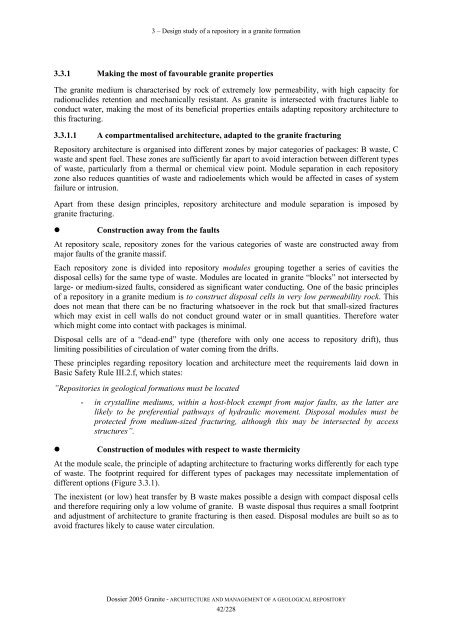Tome Architecture and management of a geological repository - Andra
Tome Architecture and management of a geological repository - Andra
Tome Architecture and management of a geological repository - Andra
You also want an ePaper? Increase the reach of your titles
YUMPU automatically turns print PDFs into web optimized ePapers that Google loves.
3 – Design study <strong>of</strong> a <strong>repository</strong> in a granite formation3.3.1 Making the most <strong>of</strong> favourable granite propertiesThe granite medium is characterised by rock <strong>of</strong> extremely low permeability, with high capacity forradionuclides retention <strong>and</strong> mechanically resistant. As granite is intersected with fractures liable toconduct water, making the most <strong>of</strong> its beneficial properties entails adapting <strong>repository</strong> architecture tothis fracturing.3.3.1.1 A compartmentalised architecture, adapted to the granite fracturingRepository architecture is organised into different zones by major categories <strong>of</strong> packages: B waste, Cwaste <strong>and</strong> spent fuel. These zones are sufficiently far apart to avoid interaction between different types<strong>of</strong> waste, particularly from a thermal or chemical view point. Module separation in each <strong>repository</strong>zone also reduces quantities <strong>of</strong> waste <strong>and</strong> radioelements which would be affected in cases <strong>of</strong> systemfailure or intrusion.Apart from these design principles, <strong>repository</strong> architecture <strong>and</strong> module separation is imposed bygranite fracturing.• Construction away from the faultsAt <strong>repository</strong> scale, <strong>repository</strong> zones for the various categories <strong>of</strong> waste are constructed away frommajor faults <strong>of</strong> the granite massif.Each <strong>repository</strong> zone is divided into <strong>repository</strong> modules grouping together a series <strong>of</strong> cavities thedisposal cells) for the same type <strong>of</strong> waste. Modules are located in granite “blocks” not intersected bylarge- or medium-sized faults, considered as significant water conducting. One <strong>of</strong> the basic principles<strong>of</strong> a <strong>repository</strong> in a granite medium is to construct disposal cells in very low permeability rock. Thisdoes not mean that there can be no fracturing whatsoever in the rock but that small-sized fractureswhich may exist in cell walls do not conduct ground water or in small quantities. Therefore waterwhich might come into contact with packages is minimal.Disposal cells are <strong>of</strong> a “dead-end” type (therefore with only one access to <strong>repository</strong> drift), thuslimiting possibilities <strong>of</strong> circulation <strong>of</strong> water coming from the drifts.These principles regarding <strong>repository</strong> location <strong>and</strong> architecture meet the requirements laid down inBasic Safety Rule III.2.f, which states:”Repositories in <strong>geological</strong> formations must be located- in crystalline mediums, within a host-block exempt from major faults, as the latter arelikely to be preferential pathways <strong>of</strong> hydraulic movement. Disposal modules must beprotected from medium-sized fracturing, although this may be intersected by accessstructures”.• Construction <strong>of</strong> modules with respect to waste thermicityAt the module scale, the principle <strong>of</strong> adapting architecture to fracturing works differently for each type<strong>of</strong> waste. The footprint required for different types <strong>of</strong> packages may necessitate implementation <strong>of</strong>different options (Figure 3.3.1).The inexistent (or low) heat transfer by B waste makes possible a design with compact disposal cells<strong>and</strong> therefore requiring only a low volume <strong>of</strong> granite. B waste disposal thus requires a small footprint<strong>and</strong> adjustment <strong>of</strong> architecture to granite fracturing is then eased. Disposal modules are built so as toavoid fractures likely to cause water circulation.Dossier 2005 Granite - ARCHITECTURE AND MANAGEMENT OF A GEOLOGICAL REPOSITORY42/228
















